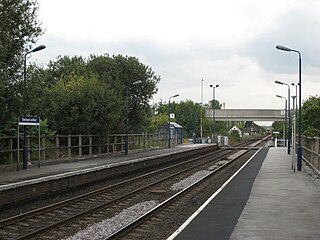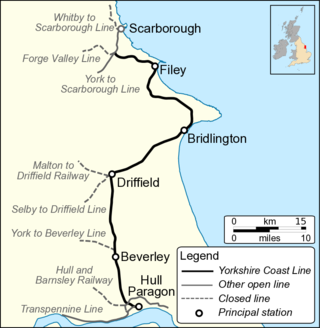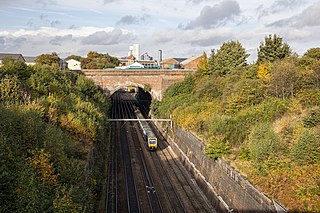
The Dearne Valley line is the name given to a railway line in the north of England running from York to Sheffield via Pontefract Baghill and Moorthorpe. The route was built over several years and consists of lines built by several railway companies.

Sherburn in Elmet is a town and civil parish in the district and county of North Yorkshire, England. It is to the west of Selby and south of Tadcaster.

Selby railway station is a Grade II listed station which serves the market town of Selby in North Yorkshire, England. The original terminus station was opened in 1834 for the Leeds and Selby Railway. The Hull and Selby Railway extended the line in 1840 and a new station was built, with the old station becoming a goods shed. The station was rebuilt in 1873 and 1891; the 1891 rebuilding was required due to the replacement of the swing bridge over the River Ouse at the same time.

Micklefield railway station serves the village of Micklefield, near Garforth in West Yorkshire, England. It lies on the Selby and York Lines, operated by Northern, 9.75 miles (16 km) east of Leeds.

South Milford railway station serves the villages of South Milford and Sherburn in Elmet in North Yorkshire, England. It lies on the Selby Line 13 miles (21 km) east of Leeds.

Church Fenton railway station serves the village of Church Fenton in North Yorkshire, England. It is situated where the Cross Country Route from Leeds to York meets the Dearne Valley line from Sheffield to York, just under 10.75 miles (17 km) from York.

Sherburn-in-Elmet railway station serves the town of Sherburn in Elmet in North Yorkshire, England. The station is located approximately 1 mile (1.6 km) from the town centre.

The Hull–Scarborough line, also known as the Yorkshire Coast Line, is a railway line in Yorkshire, England that is used primarily for passenger traffic. It runs northwards from Hull Paragon via Beverley and Driffield to Bridlington, joining the York–Scarborough line at a junction near Seamer before terminating at Scarborough railway station.

South Milford is a village and civil parish in the county of North Yorkshire, England. The civil parish includes the hamlet of Lumby, located south-west of the main village.

The Malton and Driffield Junction Railway, later known as the Malton and Driffield branch was a railway line in Yorkshire that ran between the towns of Malton, North Yorkshire and Driffield in the East Riding of Yorkshire.
The Leeds and Selby Railway was an early British railway company and first mainline railway within Yorkshire. It was opened in 1834.

The Hull and Selby Railway is a railway line between Kingston upon Hull and Selby in the United Kingdom which was authorised by an act of 1836 and opened in 1840. As built the line connected with the Leeds and Selby Railway at Selby, with a Hull terminus adjacent to the Humber Dock.

The York and North Midland Railway (Y&NMR) was an English railway company that opened in 1839 connecting York with the Leeds and Selby Railway, and in 1840 extended this line to meet the North Midland Railway at Normanton near Leeds. Its first chairman was the railway financier George Hudson, who had been called the railway king.

Marsh Lane railway station was built as the Leeds terminus of the Leeds and Selby Railway. The combined passenger and goods station opened in 1834. During the construction of the extension of the Leeds and Selby Line into central Leeds in the 1860s the station was demolished, and replaced with a large goods station and a separate through passenger station.

The Leeds and York Railway was a proposed railway line, promoted in the mid 1840s, intended to connect York and Leeds. The line lost a significant promoter, the Manchester and Leeds Railway in 1845/6 as a result of a non-competition arrangement between that company and the York and North Midland Railway.

The York and Doncaster branch was a railway line that opened in 1871 connecting Doncaster with York via Selby in Yorkshire, England. This line later became part of the East Coast Main Line (ECML) and was the route that express trains took between London King's Cross, the north of England and Scotland. It was opened by the North Eastern Railway (NER) between York and Shaftholme Junction, some 4.5 miles (7.2 km) north of Doncaster railway station. Between its opening in 1871 and the grouping in 1923, the line was used by both the NER, and the Great Northern Railway (GNR). All of the intermediate local stations that had opened with the line in 1871 closed down in the 1950s and 1960s leaving just Selby open between the town of Doncaster and the city of York.

Hambleton railway station was a railway station on the Leeds and Selby Railway in North Yorkshire, England. The station was opened with the line in 1834, closed to passengers in 1959 and then to goods in 1964. It was used sporadically in the 1970s as an embarkation point when Selby station was undergoing refurbishment. The site of the station has been partly demolished by a new railway spur built in 1983.

Milford Sidings are a set of railway sidings in South Milford, North Yorkshire, England. The railways through the site were initially opened in 1834 and 1840, when transfer and marshalling yards opened too, which handled mostly coal. However, the current sidings were developed in the 1980s to function as layover sidings for coal trains to and from the Aire Valley power stations. The sidings have access to several railway lines radiating in almost all directions.

Richmond Hill Tunnel is a railway tunnel to the east of Leeds city centre, in West Yorkshire, England. The tunnel is known to be the first in the world specifically designed to carry passengers to be worked by steam trains rather than a stationary engine. One of the innovative methods employed to reassure passengers going through the lightless tunnel, was to place copper sheets underneath the air shafts which were intended to reflect the light around the tunnel. The original Richmond Hill Tunnel was 700 yards (640 m) long, but in 1894, it was widened into a cutting with a shorter tunnel, which is the existing structure in use today. The present Richmond Hill Tunnel is 118 yards (108 m) long, and is part of the longer Marsh Lane Cutting, which connects the eastward entrance and exit into Leeds railway station to the lines going towards Selby and York.

Monk Fryston railway station was a railway station serving the village of Monk Fryston in North Yorkshire, England. Previously, Milford Junction and Old Junction served as an interchange between the Leeds and Selby and the York and North Midland Lines, however when they closed in the early 1900s, Monk Fryston was opened to cover for this loss of interchange. Though the station had four tracks through it, it only ever had two platforms. The station closed to passengers in 1959, and then completely in 1964.



















